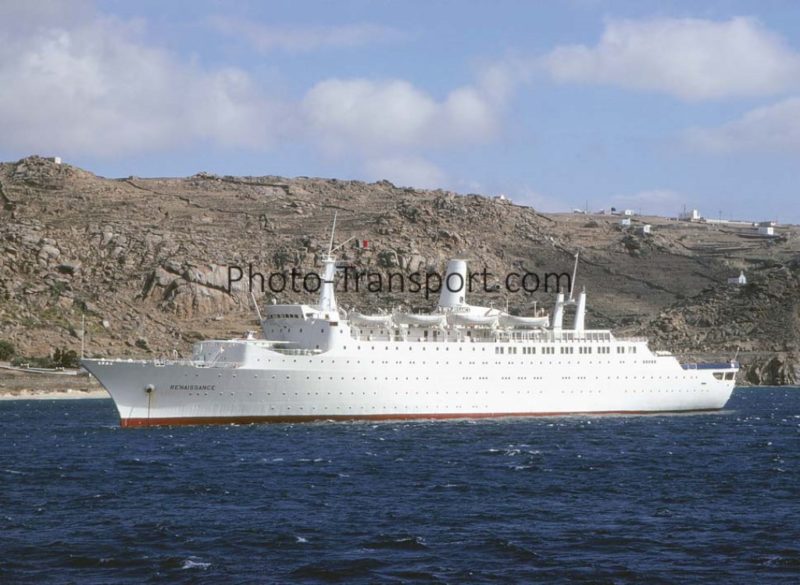
Whilst the great trans-ocean liners have inevitably garlanded the largest following and most lavish praise amongst enthusiasts, there is a sub-species of passenger ships that certainly deserves equal attention and merit. These served the world’s coastal and sea trades and amongst the last and finest of them all was the Renaissance.
Renaissance was ordered from the famous Chantiers de l’Atlantique yard at St. Nazaire in 1964. Her prospective owners were the Compagnie Française de Navigation (CFN), a subsidiary formed in 1960 of the long established Compagnie Navigation Paquet (CNP), for their Marseilles to Haifa service. The restructuring was essential to circumvent the Arab League’s boycott of companies trading with Israel, and thereby avoid any disruption to CNP’s core Morocco and West Africa service. This new subsidiary had initially utilised a pair of 8,800 grt Paquet veterans, first the 1931 built Koutoubia (renamed Phocée) and then her sister Djenné (renamed Césarée), which was built in the same year and sailed to Haifa until she was finally sent to the breakers in 1965. That year Paquet temporarily transferred it’s former flagship, the 9,931grt Lyautey to the Eastern Mediterranean route as Galilée, and she maintained the service until the advent of the new liner after which she would resort to her original name and route.
The design of the new ship, allocated shipyard number D23, was evidently influenced by Paquet’s Ancerville of 1962, and to a lesser degree the new Zim Lines flagship Shalom, both products of the same Penhoët yard. Like Ancerville it was anticipated from the start that CFN’s new vessel would operate luxury cruises in addition to her liner service. Unlike her older cousin however, Renaissance’s designers were not hampered by the need to provide three different sets of public rooms for three distinct classes of accommodation. CFN operated a single class structure which in the case of the new vessel was advertised as being all first class.
Like so many French liners CFN’s new flagship had a unique, distinctive and eye-catching profile. The hull featured a svelte and elegantly accentuated clipper bow with a neatly rounded stern. Unlike the recessed arrangement of France, Ancerville and Shalom the anchors stood proud to the hull, lodged in conventional hawse pipes. Mirroring Ancerville the four deck high superstructure rose as a pyramid, with a stepped arrangement forward and aft. Surmounting it all was a relatively tall mast, a narrow, tapered funnel and a combined twin exhaust/mainmast structure. These vertical embellishments were all raked at the same angle and the mast’s swept back arms were replicated with two prongs on the funnel’s peak, which in silhouette gave the impression of a projecting soot shield. The all white livery homogenised the tropical cruising look of Renaissance and Ancerville, however it is a shame that the distinctive funnel colours used by the three earlier CFN ships, a sky blue main body with a thin white band topped by a broader black band, was not applied. Only the black anchors and red boot topping broke the monotone white.
There were seven passenger decks, linked by a solitary lift and two main stairwells (further supplementary stairwells were further forward and adjacent to the funnel casing), providing fully air-conditioned accommodation and facilities for a total capacity of 416 passengers. They were looked after by a crew of 191. All cabins featured ensuite facilities, individual climate control and two channel radios. The largest deluxe cabins included a separate sitting area, picture windows or two portholes and some had full bath tubs. Most decks were named after either their principal room or function, however Pont des sabords and Pont batterie interestingly or bizarrely depending on your perspective, referenced fighting ships from the age of sail.

A top down tour of the passenger decks begins at the very summit with Pont des sports (Sports deck), where the bridge and chart room were located farthest forward. There was a small, raised, unnamed viewing platform above the bridge itself, which was a popular location for viewing port arrivals and departures. The majority of Pont des sports constituted unsheltered open deck space. A small deckhouse aft of the bridge housed the kennels with an adjacent dog exercise area but the only indoor facility for passengers was the gymnasium, situated in the forward part of the structure beneath the funnel. This also contained air conditioning machinery and the customary vents and air intakes.
One deck down the forward section of Pont du soleil (Sun deck), consisted of the most senior officer accommodation including the Captain’s cabin, office and dining room and cabins for the Commissaire and Chief mechanic. Other officers’ cabins stretched aft, looking out onto the open promenade situated below the three lifeboats (capacity 115) and one vedette rescue boat (capacity 60) on each side. Aft was the principal 650m² lido area and adjacent bar, with one of the ship’s two, large, rectangular outdoor pools, all of which was sheltered by extensive, staggered glazing on each flank.
Descending to Pont du grand salon (Lounge deck) passengers encountered the orientation first introduced on Ancerville, with outside cabins forward and the large main lounge located aft. Nestled in front of the main forward bulkhead was a sheltered sun deck which also incorporated the hatch cover for the single cargo hold. The associated servicing booms were manoeuvred by wires attached to bulkhead mounted winches, akin to predecessors France, Ancerville and Shalom. To port, aft of the cabins and just forward of the lounge was a small library, mirrored by a card room (specifically called the ‘salon de bridge‘) to starboard. The lounge opened out on it’s aft bulkhead to a veranda area overlooking the stern. Along Pont du salon’s centre line were shops, a photo lab and the hairdresser.
Pont du théâtre was the first full-length deck, with an open mooring deck forward which (strangely?) incorporated an exposed children’s swimming pool. Outside cabins lined the majority of each flank and although there were a few inside cabins located forward, the central section was primarily occupied by the hospital (forward) and the eponymous theatre (aft). At the stern was a further spacious lido area of 400m² complete with the ship’s other large, rectangular swimming pool.
Pont du Restaurant comprised cabins forward and aft on the port side with, as the name suggests, the full width main dining room spanning the central portion of the deck and kitchens located on the starboard aft flank. Sandwiched by the cabins and restaurant, just forward of centre was the main entrance lobby and information/reception desk. This was called ‘Agora’, a reference to the central meeting place of ancient Greek cities. The lobby was accessed through shell doors on either flank when in port and near these were two offices for the use of Police and Customs officers respectively.
A trip down the stairs to Pont des sabords (sabords were the gun ports in the side of man-o-war sailing warships) found passenger cabins to port and crew accommodation to starboard, with a further set of shell doors (hence the name?) forward. These were used when anchored and tendering at interim ports, especially the Greek Islands, on her liner service, and cruise calls when the ship was unable to go alongside. The central space adjacent to the doorways was called the Mare aux canards, which literally translates as ’the duck pond’.
The deck nearest the waterline was the Pont batterie, a reference to the lower gun decks of men-o-war. Passenger access was restricted to the forward section where there were cabins on each flank, whilst the junior dining room and, essential given her liner service, Synagogue occupied the central section.
The final deck with passenger access was deep in the ship’s bowels, called Ponte Taverne. Just forward of centre it had, as the name suggests, a drinking den decorated with imagery of an old French tavern. It might have seemed a strange location but one can imagine it as a welcome, cool air-conditioned haven from the beating sun of the Med or tropics.
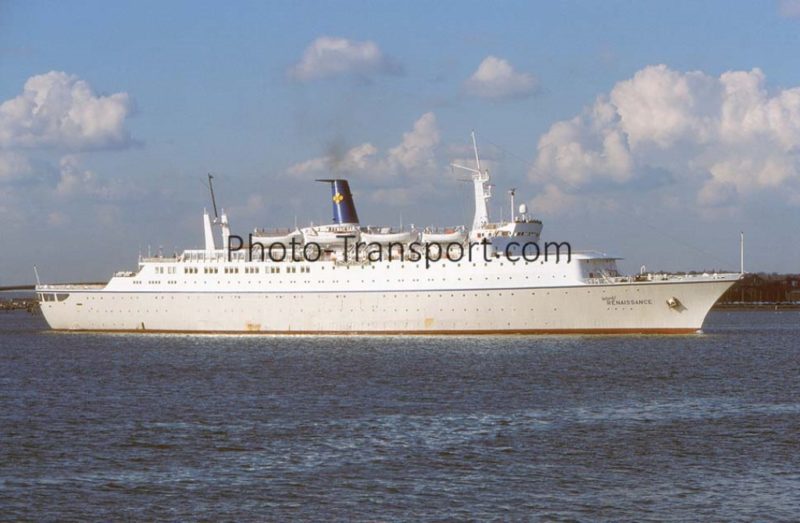
Unlike Shalom, which was completed shortly before work on CNP’s flagship commenced, Renaissance’s keel was laid on a conventional, inclined slipway. Consequently festooned with flags held aloft on temporary masts she evoked the customary dramatic spectacle when, except for the mast and funnel, the almost structurally complete ship was named and launched into the Loire on 11th December 1965. Fitting out took a further six months and in the course of trials off Belle-Île her twin Burmeister & Wain diesels, producing 13,600BHP, achieved 20 knots, allowing sufficient reserves over her 18.5 knot service speed. On 10th May 1966 Renaissance was delivered to her proud new owners and readied for service.
In fact it would be more than a month until the new company flagship embarked on her maiden voyage to Israel. Between that 30th June departure from Marseille and the end of September she operated a new, more tourist based route, calling at Iraklion and Santorini eastbound to Haifa and returning via Rhodes, Delos, Piraeus and Naples. Thereafter she reverted to the standard timetable, calling at Genoa and Messina outbound and Izmir, Piraeus and Naples on the return leg. From the beginning Renaissance’s liner schedules were interspersed with cruises, both within the Mediterranean, the Baltic and Northern Europe and in the Caribbean. She also ventured further afield, being amongst the first liners to explore the Alaskan fjords and the Amazon.

Those first passengers entered directly into the spacious ‘Agora’ lobby, with it’s contemporary, light décor. In fact it was a fitting introduction to the clean lines and sometimes futuristic style on board. Although the new ship had a very Gallic feel she incorporated a number of items from highly rated foreign designers including Raak Fuga (renowned for his light fixtures) and Eero Saarinen. The latter, a Finnish-American is arguably most famous from a shipping perspective as the original designer of the ‘tulip’ chair, that was subsequently adopted for the Queen’s Room on QE2. His output prior to a premature death in 1960 included everything from tables to airport terminals, including Washington Dulles International Airport and TWA flight centre at New York’s JFK.
Passenger numbers were already on the wane when just a year into her liner service Israel’s pre-emptive, successful military campaign known as the ‘Six Day War’ of June 1967, dissuaded yet more travellers on the Marseilles to Haifa service. Fortunately her cruising credentials were already well established and by the turn of the decade Renaissance had cemented an enviable reputation in the growing cruise market, where her small ‘yacht-like’ size, modern internal and external styling, state of the art facilities and unmistakable French character and cuisine made her very popular. In 1970 a further restructuring (effectively a consolidation of the dwindling fleet) saw Renaissance join Ancerville and the rebuilt, former Fabre Line ship Jean Mermoz under Paquet’s Nouvelle Compagnie de Paquebot’s umbrella. The former liner services were all discontinued and the ships that were not considered suitable for cruising disposed of.
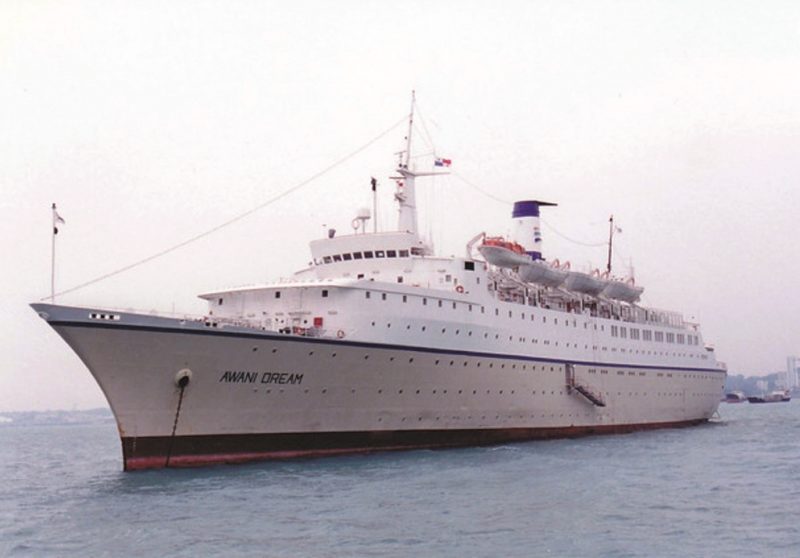
For the next seven years Renaissance continued to prosper, renowned for her interesting itineraries and French style, she also became famous for annual Music Festival at Sea cruises. Nevertheless, like so many others Paquet Line was struggling to maintain profitability in the face of escalating fuel and crew costs and increased competition. In 1973 Ancerville had been sold to the Peoples Republic of China, and when the Greek Epirotiki Line approached Paquet about acquiring Renaissance in 1977 there was little hesitation in accepting. The sale contract was signed on 28th October and she arrived in Piraeus, from Miami, on 2nd December.
Epirotiki initially renamed their new acquisition, nominally designated the company’s flagship, Homeric Renaissance and she was given a brief refit. Internally this resulted in the addition of several new cabins, some of which were merely a change of use, with officer’s accommodation adjacent to the open promenade on Sun Deck and the doctor and nurse’s quarters on Theatre Deck transferred to passenger use. A large suite was created out of the former children’s play room aft on the port side of Theatre Deck and several interior cabins hewn out of the little ones’ dining room on Batterie Deck. Also on this deck the former Synagogue was converted into two cabins, whilst up the stairs on Sabords Deck the intriguing ’Duck pond’ made way for three additional cabins.
Almost immediately Italy’s Costa Line approached the new Greek owners and negotiated a charter agreement, so she emerged in 1978 sporting Costa’s trademark yellow funnel and a different name, World Renaissance. From a marketing perspective the slim stack ill-suited Costa’s big blue C and bracketing commas and caused something of a headache for publicity ‘shots’ which invariably required doctoring to try and fit all the symbols in. As well as embellishing her original name the decks were anglicised so Sports Deck, Sun Deck, Theatre and Restaurant decks replaced their French namesakes. Interestingly though the Gallic nomenclature was retained for Grand Salon, Sabords, Batterie and Taverne decks.
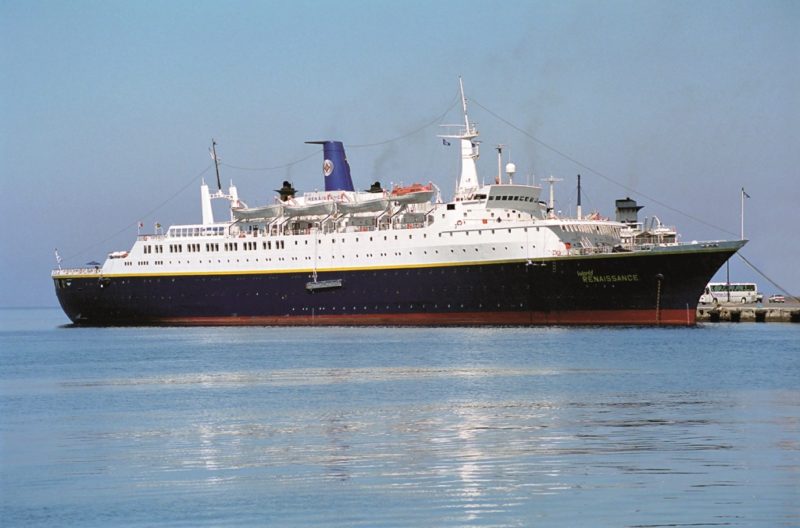
Marketed with the advertising tag line ‘The fun never sets onboard the M/S World Renaissance’ Costa’s new ship neatly slotted into the line’s expanding fleet of owned and chartered tonnage. Like most of her new fleet mates her itineraries were generally centred on the Caribbean but also included transits of the Panama Canal to Pacific coast ports, or extended southerly sailings to Latin America. The ocean liner’s nemesis, the jet aircraft, now became her indispensable ally, flying passengers from across the continent to embarkation ports like San Juan and Port Everglades. Costa offered ‘free’ flights with many of its cruise packages and Renaissance proved to be one of its most popular vessels. Although she retained her French décor, was registered in Greece and her crew hailed from across Europe, World Renaissance was heavily marketed as an Italian ship. It was a winning formula.
Towards the end of her Costa career World Renaissance undertook a single, exceptional voyage between Plymouth and Cape Town, under charter to the St. Helena Line and the South African travel company TFC tours. Having sailed from the UK on 25th November she called at Tenerife and St. Helena en-route to the Cape. Despite her popularity Costa decided not to renew the charter of World Renaissance in 1985. In the early 1980s Costa was restructured, coming out of the private, family control that had maintained the business from it’s conception almost six decades before, to become publicly owned. Although some of the older stalwart vessels were retained the new management implemented a fleet expansion and renewal programme, squarely aimed at maintaining the company‘s position in the increasingly competitive Caribbean cruise trade. World Renaissance was one of those vessels regarded as surplus to requirements. In fact the timing also suited Epirotiki who belatedly introduced her into their own fleet, sensibly retaining her well reputed name. Sporting the company’s distinctive sandy coloured hull, topped by a thin blue band and a blue funnel incorporating a yellow Byzantine cross, she arguably looked more handsome than ever. As part of the refit all the decks and major public rooms were renamed after classical Greek gods to reflect her Hellenic ownership, thus Sports deck became Jupiter deck, Sun Deck became Hera deck and in descending order the others were now named Apollo, Venus, Dionysos, Poseidon, Nereus and Oceanus. She initially operated cruises out of Piraeus, mainly to the Greek islands and Eastern Mediterranean. Subsequently however her itineraries diversified and she also sailed once more in the Caribbean and around North and South America.
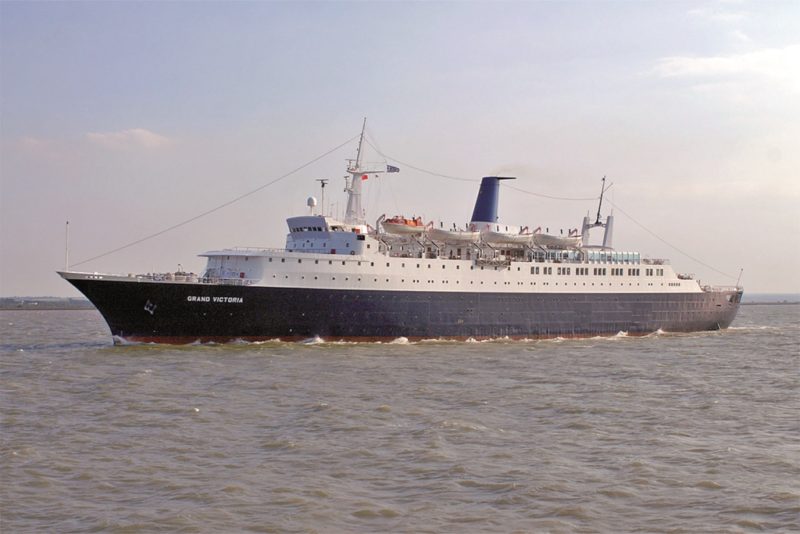
At some point in the late 1980s Epirotiki invested in a significant refit for World Renaissance. By extending the former Grand Salon deck forward and removing the now redundant cargo hatch and associated deck gear, the company were able to add ten spacious outside cabins and five interiors on what was now Apollo deck. Furthermore the shaft down to the hold could now be converted into additional deck space, with fourteen cabins added over four decks. One casualty of the refit was the Taverne down on Oceanus deck, part of which was converted into yet more cabin accommodation.
Over the next ten years World Renaissance gave excellent service to Epirotiki. There do not appear to have been any significant incidents or mechanical problems in this time, in fact it was the company itself rather than it’s flagship which drew industry and media attention. In 1993 rumours suggested that the company would merge with fellow Greek operator Sun Line but instead they entered into a partnership agreement with cruising powerhouse Carnival Corporation, which ultimately acquired 49 per cent of the share capital in Epirotiki, the maximum that could be owned by a non-Greek operator under the country’s cabotage legislation. The arrangement was ostensibly designed to give Carnival a shoe into the European cruise market, and their intention was to modernise both the fleet and shore side operations but it stoked vehement protests from the country’s maritime unions. Ultimately in April 1995, less than two years after the initial partnership started, Carnival sold its stake back to Epir Holdings which represented Potamianoås family interests, for whom Epirotiki represented over 160 years of invested time, money and passion. Carnival chairman Micky Arison cited the reason for what was regarded as an amicable split as “…..because of different strategic directions and cultural differences, it was in the best interests of both companies to separate.” It was clear from the start that there were significant differences in the aims and objectives of the two parties. The apparent failure of the arrangement certainly didn’t dissuade Carnival who would soon afterwards acquire a majority stake in another major Mediterranean cruise operator, Costa, and then expand exponentially with further acquisitions. Epir Holdings meanwhile returned to the negotiating table and four months after breaking up with Carnival the proposed merger with Sun Line took place. The combined Royal Olympic Cruise Line was formed.
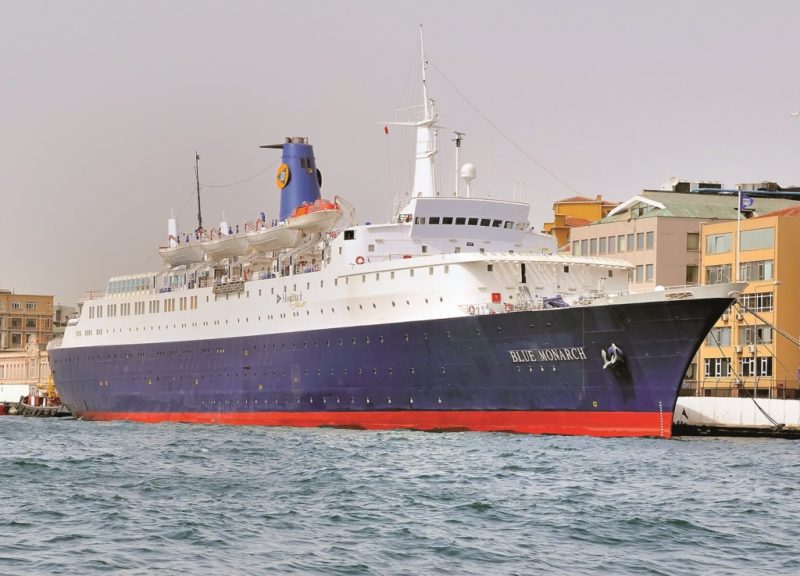
At the time of this announcement Epirotiki also publicised a new winter season of cruises for World Renaissance for 1995. In a return to her original stamping ground she was scheduled to operate cruises from Israel to Jordan and Egypt, but it was an itinerary she would never fulfil. Looking to expand it’s established Club Awani leisure business Indonesia’s Awani Modern Group bought World Renaissance as their first ship in an ambitious new cruise line project. Renamed Awani Dream she was sent to Koja Bahari-wharf shipyard in Jakarta for a refit, before commencing a South East Asian cruise programme. Unfortunately several factors meant the new venture struggled to take off and ultimately collapsed. Awani were pitching their new ‘brand’ at the luxury end of the cruise market, but World Renaissance and their other acquisition, Awani Dream 2, the former Cunard Countess, were ageing ships. Whilst both undoubtedly had their devotees, for new cruise goers in particular they had been surpassed by the competitors more modern cruise ships. A general slump in the market led to Awani’s collapse and so in January 1998 she was sold back to Royal Olympic for $14 million.
After negotiations for a charter to South Pacific Cruises (for which she would have sailed as Alloura) broke down, the ship reverted to her former name of World Renaissance and was assimilated into the Royal Olympic fleet. At this time the new combined Greek operation was looking to modernise its ships. Both Epirotiki and Sun Line had built solid reputations utilising small, superannuated liners in a niche market. The Royal Olympic management now decided to invest in a pair of radical new vessels. At about 25,000 grt they were of similar size to their older fleet mates but an exceptionally high service speed of 27 knots was specifically conceived to allow ‘three continent’ cruises from Piraeus. Funding for the project was through a separate company.
Royal Olympic’s woes were manifold and in many ways Epirotiki’s problems were simply transferred to the new company. Financial concerns were exaggerated by the repercussions of the 9/11 attacks in the United States, which impacted on the global cruise market. However the company also became embroiled in a disagreement with the International Olympic Committee regarding rights to the ‘Olympic’ name. Ultimately it had to re-brand itself and where relevant, its ships, under the revised ‘Olympia’ label.
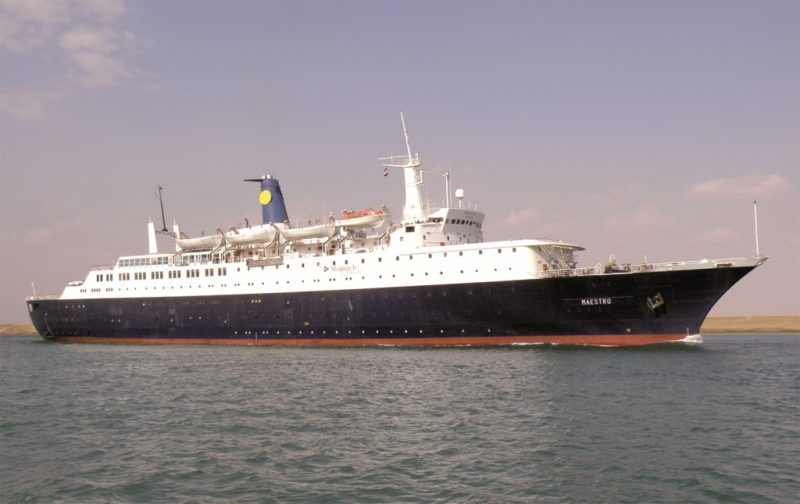
World Renaissance sailed for Royal Olympic/Olympia for six years but despite dragging on for as long as possible, the amalgamated company ultimately became insolvent and folded in the Autumn of 2004. The almost forty year old ship was laid up at Piraeus and perhaps inevitably there were thoughts in shipping circles that she would be joining contemporaries on the one-way voyage to the knackers yards of Asia. In fact a reprieve came when she was purchased at auction for about $3 million by Pelorus Maritime Inc. and placed under the management of Elysian Cruise Lines. Sporting a plain blue hull and funnel and renamed Grand Victoria, the erstwhile Renaissance embarked on a series of European cruises under charter to the Russian based Metropolis Tur travel company. Although two years later, at the end of 2006, the charter came to an end even now the veteran liner found her niche, for the following summer season she was chartered by the Greek owned Blue Monarch Shipping, a division of Classic International Cruises, and received her sixth name, Blue Monarch, for a series of three, four and seven day Greek Island cruises. Evidently the programme was sufficiently successful to prompt Blue Monarch Shipping into seriously considering a purchase offer for the ship. However the price tag was too high, especially considering the extensive work necessary for her to be compliant with the impending 2010 SOLAS regulations. In October 2009 the now surplus ship was laid up at Perama on the Saronic Gulf coast, with little prospect of future employment.
Despite initial interest in using her as an accommodation ship at the 2010 Winter Olympics in Vancouver, she was predictably sold in February 2010 for $1.8 million to Indian scrap merchants. Nevertheless her last voyage east would prove anything but straightforward. She departed Perama under the name Maestro but was laid up again at Port Said. The reason was the volatile price of scrap at the time, her new owners rather optimistically hoped they could find a buyer interested in using her for further trading. When this failed she was moved to an anchorage off Mumbai with the same intention. Ultimately her time ran out and in August 2010 she was moved along the coast to be beached for breaking at Alang.

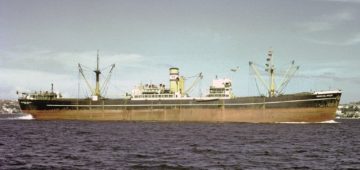



Comments
Sorry, comments are closed for this item